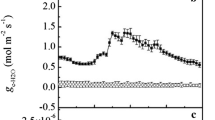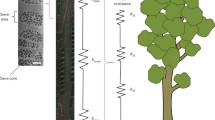Abstract
Living tissue in tree stems has to be supplied with oxygen, which can be transported upwards with the transpiration stream; but in times of zero sapflow, the only source is the oxygen stored or diffusing radially through bark and xylem. We measured radial and axial diffusion of oxygen against nitrogen gas in wood of coniferous (Picea abies (L.) Karst. and Taxus baccata L.), ring-porous (Quercus robur L. and Fraxinus excelsior L.) and diffuse-porous (Fagus sylvatica L. and Carpinus betulus L.) trees at different water and gas contents in the laboratory. The diffusion coefficient (D) in radial direction was mostly between 10−11 and 10−7 m2 s−1 and was strongly related to the gas content. At 40% gas volume, D increased 5–13-fold in Picea, Taxus and Quercus, 36-fold in Fraxinus, and about 1000-fold in Carpinus and Fagus relative to D at 15% gas volume. In the axial direction, diffusion was 1 or 2 orders of magnitude faster. Between-species differences in diffusion velocities can largely be explained by wood structure. In general, D was lowest in conifers, highest in diffuse-porous and intermediate in ring-porous hardwoods, where the large vessels were mostly blocked by tyloses. Model calculations showed that at very high water content, radial diffusion can be too low to ensure the supply of respiring sapwood with sufficient oxygen and an important function of gas in living stems appears to be the supply of oxygen through storage and diffusion.




Similar content being viewed by others
References
Bramhall G, Wilson JW (1971) Axial gas permeability of Douglas fir microsections dried by various techniques. Wood Sci 3:223–230
Buchel HB, Grosse W (1990) Localization of the porous partition responsible for pressurized gas transport in Alnus glutinosa (L.) Gaertn. Tree Physiol 6:247–256
Carlquist S (1988) Comparative wood anatomy. Springer, Berlin Heidelberg New York
Cherubini P, Schweingruber FH, Forster T (2003) Morphology and ecological significance of intra-annual radial cracks in living conifers. Trees 11:216–222
Choong ET, McMillin CW, Tesoro FO (1975) Effect of surface preparation on gas permeability of wood. Wood Sci 7:319–322
Comstock GL (1967) Longitudinal permeability of wood to gases and nonswelling liquids. Forest Prod J 17:41–46
del Hierro AM, Kronberger W, Hietz P, Offenthaler I, Richter H (2002) A new method to determine the oxygen concentration inside the sapwood of trees. J Exp Bot 53:559–563
Edwards NT, Hanson PJ (1996) Stem respiration in a closed-canopy upland oak forest. Tree Physiol 16:433–439
Eklund L (2000) Internal oxygen levels decrease during the growing season and with increasing stem height. Trees 14:177–180
Eklund L, Klintborg A (2000) Ethylene, oxygen and carbon dioxide in woody stems during growth and dormancy. In: Savidge R, Barnett J, Napier R (eds) Cell & molecular biology of wood formation. BIOS Scientific Publishers, Oxford. pp 43–56
Gansert D (2003) Xylem sap flow as a major pathway for oxygen supply to the sapwood of birch (Betula pubescens Ehr.). Plant Cell Environ 26:1803–1814
Gansert D (2004) A new type of cuvette for the measurement of daily variation of CO2 efflux from stems and branches in controlled temperature conditions. Trees 18:221–229
Gansert D, Burgdorf M, Lösch R (2001) A novel approach to the in situ measurements of oxygen concentrations in the sapwood of woody plants. Plant Cell Environ 24:1055–1064
Gartner L, Moore JR, Gardiner BA (2004) Gas in stems: abundance and potential consequences for tree biomechanics. Tree Physiol 24:1239–1250
Grosse W, Frye J, Lattermann S, Nambiar EKS, Sands R (1992) Root aeration in wetland trees by pressurized gas transport. Tree Physiol 10:285–295
Hansmann C, Gindl W, Wimmer R, Teischinger A (2002) Permeability of wood – a review Wood Res 47:1–16
Hicks WT (2000) Modelling nitrogen fixation in dead wood. Ph.D. dissertation, Corvallis State University, Corvallis, OR
Holst G, Glud RN, Kühl M, Klimant I (1997) A microoptode array for fine-scale measurement of oxygen distribution. Sens Actuators B 38-39:22–129
Hook DD, Brown CL (1972) Permeability of the cambium to air in trees adapted to wet habitats. Bot Gazette 133:304–310
Hook DD, Brown CL, Wetmore RH (1972) Aeration in trees. Bot Gazette 133:443–454
Isaacs CP, Choong ET, Fogg PJ (1971) Permeability variation within a cottonwood tree. Wood Sci 3:231–237
Kazemi SM, Dickinson DJ, Murphy RJ (2001) Effects of initial moisture content on wood decay at different levels of gaseous oxygen concentrations. J Agric Sci Technol 3:293–304
Knoke T (2003) Predicting red heartwood formation in beech trees (Fagus sylvatica L.). Ecol Mod 169:295–312
Lavigne MB, Franklin SE, Hunt ER (1996) Estimating stem maintenance respiration rates of dissimilar balsam fir stands. Tree Physiol 16:687–696
Mancuso S, Marras AM (2003) Different pathways of the oxygen supply in the sapwood of young Olea europaea trees. Planta 216:1028–1033
Militz H (1993) Meßmethoden zur Bestimmung der Permeabilität von Fichtenholz gegenüber Luft und Wasser. Holz Zentralblatt 115:1798–1802
Niemz P (1993) Physik des Holzes und der Holzwerkstoffe. Leinfelden, Germany, DRW-Verlag
Nobel PS (1991) Physicochemical and environmental plant physiology. Academic Press, San Diego
Pausch RC, Grote EE, Dawson TE (2000) Estimating water use by sugar maple trees: considerations when using heat-pulse methods in trees with deep functional sapwood. Tree Physiol 20:217–227
Petty JA (1973) Diffusion of non-swelling gases through dry conifer wood. Wood Sci Technol 7:297–307
Phillips N, Oren R, Zimmermann R (1996) Radial patterns of xylem sap flow in non-, diffuse- and ring-porous tree species. Plant Cell Environ 19:983–990
Prak AL (1970) Unsteady-state gas permeability of wood. Wood Sci Technol 4:50–69
Schweingruber FH (1990) Anatomie europäischer Hölzer. Anatomy of European Woods. Eidgenössische Forschungsanstalt für Wald, Schnee und Landschaft. Birmersdorf (Hrsg.), Haupt, Bern, Stuttgart
Sebastian LP, Siau JF, Skaar C (1973) Unsteady-state axial flow of gas in wood. Wood Sci 6:167–174
Siau JF (1976) A model for unsteady-state gas flow in the longitudinal direction of wood. Wood Sci Technol 10:149–153
Siau JF (1984) Transport processes in wood. Springer, Berlin Heidelberg New York
Spicer R, Holbrook NM (2005) Within-stem oxygen concentration and sap flow in four temperate tree species: does long-lived xylem parenchyma experience hypoxia? Plant Cell Environ 28:192–201
Stockfors J, Linder S (1998) Effect of nitrogen on the seasonal course of growth and maintenance respiration in stems of Norway spruce trees. Tree Physiol 18:155–166
Strand VV, Weisner SEB (2002) Interactive effects of pressurized ventilation, water depth and substrate conditions on Phragmites australis. Oecologia 131:490–497
Teskey O, McGuire MA (2002) Carbon dioxide transport in xylem causes errors in estimation of rates of respiration in stems and branches of trees. Plant Cell Environ 25:1571–1577
Tesoro FO, Choong ET, Skaar C (1966) Transverse air permeability of wood as an indicator of treatability with creosote. Forest Prod J 16:57–59
Tyree MT, Zimmermann MH (2002) Xylem structure and the ascent of sap. 2nd edn. Springer, Berlin
Von Willert DJ, Matyssek R, Herppich W (1995) Experimentelle Pflanzenökologie. Thieme, Stuttgart
Yokota T (1967) Diffusion of non swelling gas through wood. Mokuzai Gakkaishi 13:225–231
Acknowledgements
We thank Dr. Raphael Klumpp of the Department of Forest and Soil Sciences BOKU and Mr. Fiedler of the Forstverwaltung Lainzer Tiergarten for providing wood for the experiments. We are also grateful to Veronika Knoblich of the Institute of Wood Science and Technology for her help in processing the wood specimen, to Dr. Christian Hansmann for helping find literature and to Gunther Mack for the design of Fig. 1. Two anonymous reviewers provided helpful comments.
Author information
Authors and Affiliations
Corresponding author
Rights and permissions
About this article
Cite this article
Sorz, J., Hietz, P. Gas diffusion through wood: implications for oxygen supply. Trees 20, 34–41 (2006). https://doi.org/10.1007/s00468-005-0010-x
Received:
Accepted:
Published:
Issue Date:
DOI: https://doi.org/10.1007/s00468-005-0010-x




